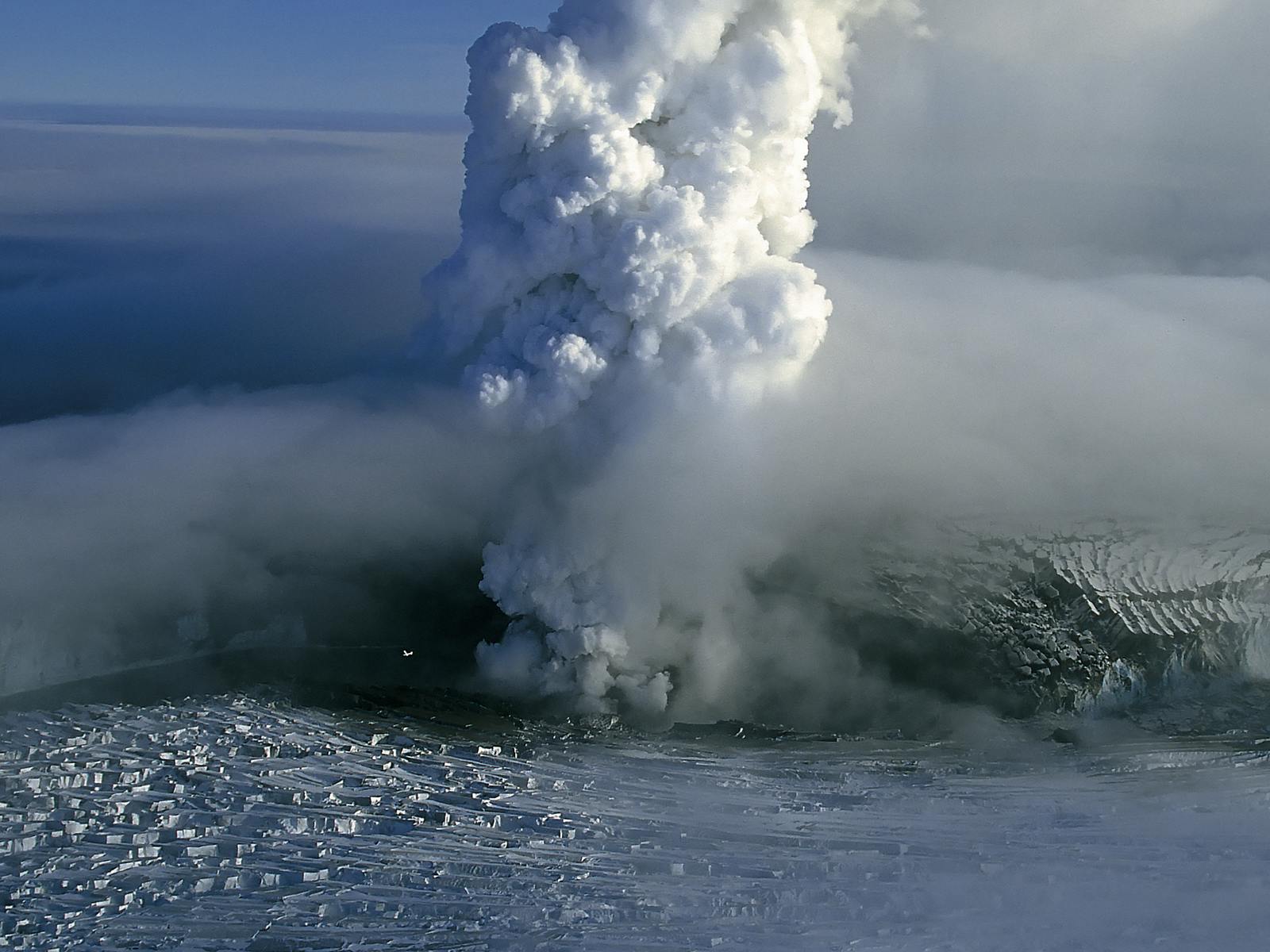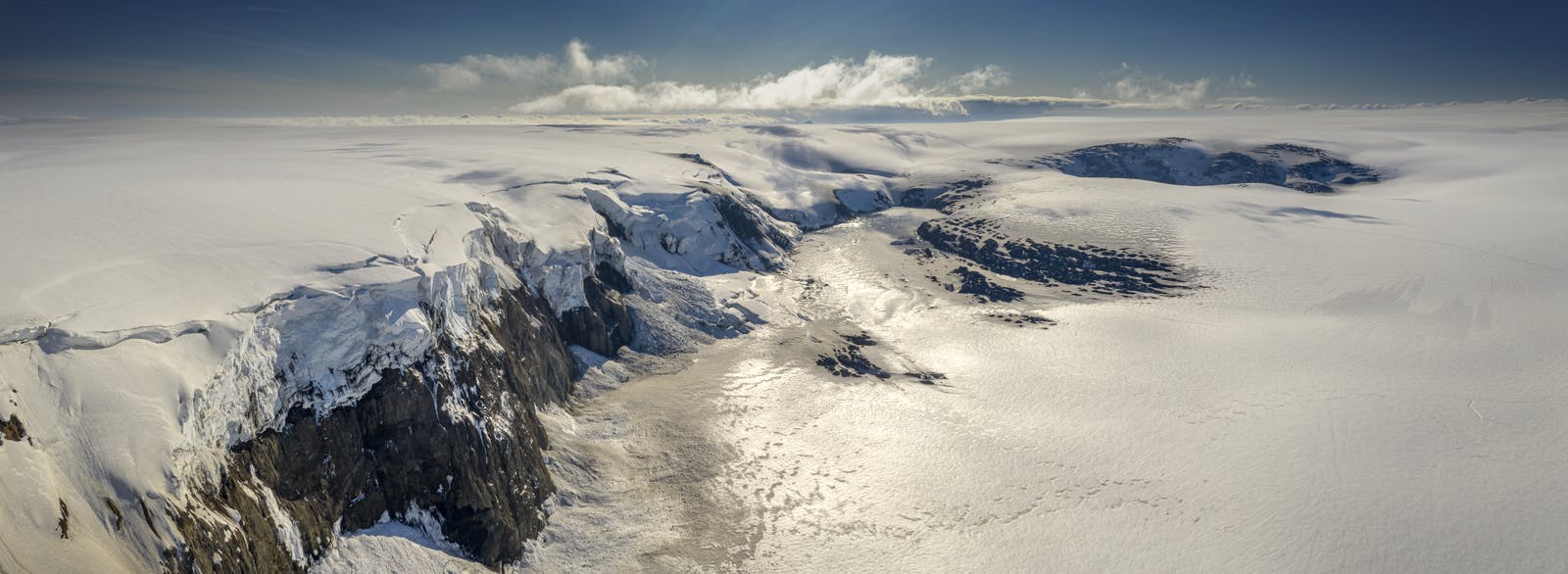
Eruptions of Grímsvötn Volcano
Grímsvötn volcano has a subglacial caldera buried beneath the massive Vatnajökull glacier. The wide depression forming the caldera measures about 8 kilometres in diameter, making it one of the largest calderas in Iceland. Its eruptions are highly explosive and produce a giant ash cloud, given that the volcano sits below the ice cap.
When Has Grimsvötn Erupted Throughout History?

Grímsvötn’s eruptions are often characterised by the interaction between magma and ice, leading to explosive volcanic activity and ash plumes surging thousands of metres into the air. The most recent major eruption of Grímsvötn was in 2011 and lasted for a few days.
Below is a timeline of eruptions during the last 100 years at Grímsvötn:
- 1922 — An eruption occurred between 29 September and 23 October, resulting in a large glacier flood, jökulhlaup
- 1934 - An eruption started 30 March along with a gigantic glacier flood, 30,000 - 40,000 thousand m3/sec.
- 1938 — A powerful eruption occurring in May and June, producing glacier flooding reaching 30,000 - 40,000 m3/secat the Skeiðará and Sula rivers.
- 1983 — There was an eruption over a period of four days that didn’t create significant glacial flooding.
- 1996 — A fissure eruption in the so-called Gjálp, between Bárðarbunga and Grímsvötn, fills the Grímsvötn caldera with meltwater, and causing significant flooding after the eruption started. The meltwater flood destroyed bridges and cut apart the Ring road, Route 1, in Skeiðarársandur.
- 1998 — A small eruption within Grímsvötn caldera; no glacial flooding.
- 2004 — Earthquake swarms followed by an eruption and glacial flooding.
- 2011 — The last eruption of Grímsvötn as of July 2023, with heavy ash fall but no flooding.
When Grimsvötn Erupts, Are There Glacial Floods?

Beneath the ice cap, Grímsvötn holds a subglacial lake, there is also a hidden high temperature area with boiling springs, fumaroles and geysirs melting the glacier ice. Additionally, during eruptions, the heat from the volcano melts large quantities of ice. This leads to the sudden release of water. These glacial outburst floods can be powerful and can carry significant amounts of sediment and debris downstream at a high-speed rate. There are warnings and alerts in place before an eruption, so there is no significant risk of loss of life.
Is Grimsvötn Volcano Active?
Grimsvötn is considered an active volcano; the most active one in Iceland with 70 eruptions in historical time, however, there are no indications of an imminent eruption. Local scientists constantly monitor the volcano systems throughout Iceland, and there are usually episodes of earthquakes giving warnings of an eruption.
Learn About Volcanoes at Perlan in Reykjavík

In the heart of Reykjavík, Perlan’s Forces of Nature exhibition allows guests to feel the immense power of volcanoes, earthquakes, and geothermal energy that powers the island. Visitors can learn about the volcanoes that form when heat and pressure build up beneath the earth’s surface. The earth’s weak points tend to be along fault lines where tectonic plates converge or diverge, as in Iceland’s case. The exhibition is a unique, family-friendly museum experience that entertains and informs. Perlan is also home to exhibitions featuring ice caves and northern lights.
FAQ

What would happen if the Grimsvötn volcano erupted?
If Grimsvötn erupted, the airspace around the volcano would be closed, and any individuals close to the region would be evacuated. However, given that it is located in a remote slice of Iceland, there are no nearby settlements and little danger to people. An eruption is unlikely to be a surprise given that geologists monitor the active volcano systems in Iceland, and there would be warnings of an imminent eruption.
Is Grimsvötn safe to visit?
Grimsvötn is in the remote highlands of Iceland and is not considered a major tourist attraction. Hiking enthusiasts may get close to the volcano during extensive highland treks, but these are not high numbers. However, the Grimsvötn volcano is safe to visit as the Icelandic Meteorological Office closely monitors it. It’s essential to prioritise safety and follow the guidance of local authorities regarding access to and around the volcano.
For any hike, it’s essential to dress in proper clothing for the conditions, bring food and water, have a charged mobile phone and leave your travel plans at www.safetravel.is.
When is the best time to visit volcanos in Iceland?
If you want to join volcano hiking tours, the best time to visit would be in the summer months. The summer provides the best chance of good weather, mild temperatures and organised tours. However, if you want to learn about volcanoes without climbing one, visiting Perlan’s exhibitions is ideal. The interactive and information exhibitions are excellent.
Is it dangerous to visit glaciers?
Yes. Glacier guides are trained and know the surroundings well. They will lead the group and provide instructions and equipment like crampons. They are trained to keep you safe.
Popular articles

Reykjanes Volcanoes Overview
Enjoy a complete overview of the Reykjanes Volcanoes from 2021-2024. Learn about its geology, recent activity, and visitor tips for a safe, memorable experience.

Reykjanes Peninsula Volcanoes: Sundhnúksgígar Eruptions
The anticipated volcano has erupted in the Reykjanes Peninsula, the site is being called Sundhnúkagígar. See the historic insights on the seismic activity and volcanic eruptions.

Earthquakes in Iceland
Earthquakes in Iceland are a fact of life. Each year, hundreds of small tremors shake the earth, a reminder of the country’s position on a tectonic plate boundary.

Volcano Museums and Exhibitions in Iceland
If you don't manage to visit an actively erupting volcano in Iceland - Experience its force at one of these excellent volcano museums and exhibitions in Iceland.

Top 10 Places To See the Northern Lights in Iceland
You can see the northern lights across the country, but some spots are more suitable than others. Find the best place to see the northern lights in Iceland.

Ice Caves From Reykjavik
Travel beyond the capital for a closer look at an ice cave under one of Iceland’s glaciers. If you can’t spare the time, experience Perlan’s ice cave in Reykjavik.